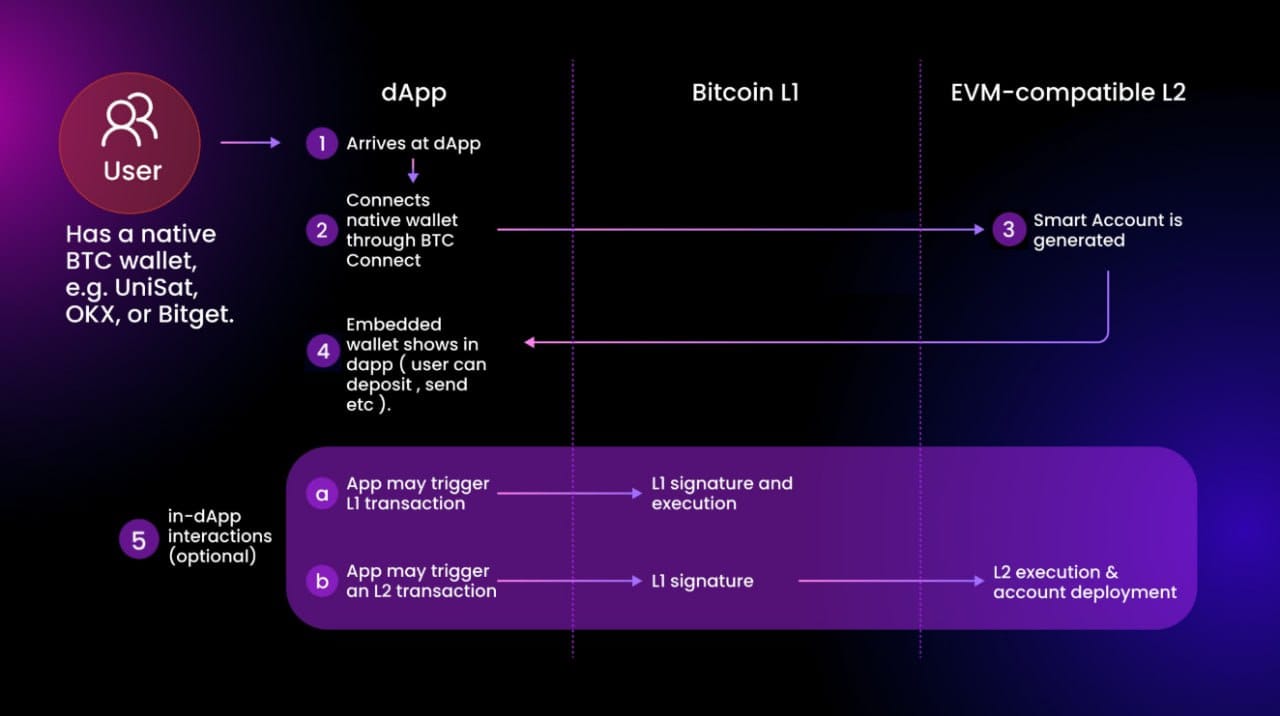Breaking Through Chain Abstraction on Bitcoin: BTC Connect

Table of Contents:
The Bitcoin ecosystem has entered an accelerated growth and evolution phase.
Many consider that 2023 and 2024 will be remembered as the years of bleeding-edge Web3 innovation arrived at Bitcoin. Amongst this revolution, a growing ecosystem of EVM-compatible L2s, Ordinals, BRC-20 tokens, and new dApps has sparked. However, despite abundant solutions addressing the chain’s scalability/cross-compatibility issues, one key area is left needing improvement: user experience (UX).
As Bitcoin’s value proposition continues to stand the test of time, its expanding ecosystem faces the sudden need for simplified user interactions across Bitcoin L1 and its EVM-compatible Layer-2 counterparts. The solution to this requires abstracting away the complexities associated with users’ interactions throughout the ecosystem –a problem tackled by account abstraction (AA) in EVM blockchains.
To this end, we recently introduced BTC Connect, the first-ever account abstraction protocol for the Bitcoin ecosystem and the first breakthrough towards chain abstraction encompassing Bitcoin. In this article, we’ll discuss BTC Connect’s impact, its rationale, its user flow, and chain abstraction as a whole.
What is chain abstraction, and what does it have to do with Bitcoin?
Web3 is a complex labyrinth to navigate. This is especially true for newer users, since to comfortably interact with Web3, they must first understand how to deal with:
- Multiple Layer-1 and Layer-2 blockchains.
- dApps hosted only on specific chains.
- Bridges and cross-chain solutions.
- Fragmented liquidity.
These, among other problems, cause even the most alluring applications, solving real problems, to struggle to drive adoption.
Chain abstraction, as you probably guessed, refers to creating and automating solutions that turn interactions across chains into mere infrastructure details, rather than forcing users to manually navigate through them. This, in turn, enables Web3 applications and solutions to focus on achieving users’ goals rather than constantly facing the friction of interacting across blockchains.
At Particle Network, our goal is to create chain abstraction infrastructure and build it in an intrinsically modular way, giving developers and projects the option of integrating whichever of its components are useful to their specific application.
Bitcoin, as the first, largest, and most valuable blockchain in Web3, becomes an obvious candidate for chain abstraction given its inherent differences with the Ethereum Virtual Machine (EVM). As such, we’ve made it a priority to build the required infrastructure for chain abstraction encompassing this ecosystem, giving birth to BTC Connect: the premier Bitcoin account abstraction protocol.
Why Bitcoin Account Abstraction?
Since the need for AA on Bitcoin might not be immediately obvious for users primarily focused on the Bitcoin ecosystem (i.e., those only vaguely familiar with the latest trends on the Ethereum and larger Web3 world), let’s quickly go over this.
AA has the main purpose of improving Web3’s UX to make interactions as flexible as possible, allowing developers to simplify user experience –a prerequisite to onboarding a mass market of users to a growing ecosystem of decentralized products.
In short, AA aims to achieve this by turning users' wallets into smart contracts, making them intrinsically programmable. This results in greater flexibility upon usage, bringing along a wide array of use cases, such as:
- Transaction sponsorship: Transactions can be sponsored or paid for by third parties, enabling gasless user activity.
- Multi-signature transactions and advanced security policies: Developers can set up complex systems requiring multiple signatures or complex conditions for specific interactions. This enhances security for sensitive operations such as corporate treasury management or decentralized governance operations, also allowing general users to set up 2FA, guardians, and other dynamics for their wallets.
- Transaction automation: With programmable accounts, users can authorize recurring transactions to be automatically executed, streamlining different on-chain services, such as subscriptions.
- Delegated transactions: Users can delegate certain types of transactions to eliminate manual signatures, allowing for more immersive experiences in SocialFi, gaming, etc.
- In advanced applications, privacy, and cross-compatibility options.
The above is not an exhaustive list. These are just a few use cases made possible by AA, a novel field where innovation can still blossom into new, exciting possibilities.
At this point, you may think that, while this is all fine, it’s impossible to turn wallets into smart contracts on Bitcoin without fundamentally altering the blockchain. While you’d be right, you’d be surprised to hear that neither of these happened in Ethereum. Account Abstraction was formalized in the EVM ecosystem through ERC-4337, a proposal that standardized an intrinsically modular, standard set of contracts to achieve AA without making direct changes to the Ethereum network.
With BTC Connect, we've created an ingenious design that leverages the dynamics made possible by ERC-4337 on the BTC ecosystem by tapping into EVM-compatible BTC L2s. Let’s now dive into its specifics.
BTC Connect's design and user experience
As mentioned, BTC Connect’s design is simple yet elegant. You can see this in the following demo:
Releasing BTC Connect: The First Account Abstraction Protocol for the #Bitcoin Ecosystem.
— Particle Network (@ParticleNtwrk) January 24, 2024
For the first time, we're merging Bitcoin's hard-asset properties with Ethereum's most advanced technology.
BTC Connect elevates your native Bitcoin wallet to an EVM-compatible smart… pic.twitter.com/3ja6g67vQw
Short video showcasing an example utilization of BTC Connect
In short, for the end user, using BTC Connect looks as follows:
- The user arrives at a decentralized application integrating BTC Connect.
- Within it, they connect a BTC native wallet, such as UniSat, OKX, TokenPocket, or Bitget.
- Upon successful connection, a Smart Account within the app’s target Bitcoin L2 is created. At this point, the user has two accounts: their existing BTC wallet and an associated Smart Account. The Smart Account can be accessed through a wallet interface embedded within the dApp (see the image below). Since this wallet is securely linked to and only accessible by authenticating the user’s Bitcoin wallet, it remains solely within their control.

The user can then interact with the dApp in two ways:
- By triggering Bitcoin L1 transactions, authenticated by their native wallet, and spending funds on it. Two examples of this interaction could be to bridge funds to a Bitcoin L2 or send a payment in BTC.
- By triggering transactions on their Smart Account. These can be smart contract interactions, token transfers, bridging, etc. In this interaction, users can benefit from account abstraction's perks, such as gasless transactions, by using only their Bitcoin wallet. Should the interaction involve the expenditure of any funds within the Smart Account, the user can fund their wallet as they would with any other solution.
The process can be diagrammed as follows:

From an architectural perspective, BTC Connect is constituted by the following components:
- A connection modal aggregating BTC wallets and directly facilitating connection.
- An associated smart account deployed on EVM-compatible Bitcoin Layer-2s, authenticated by the previously connected Bitcoin wallet.
- Account abstraction infrastructure on said Layer-2s, such as Particle's Omnichain Paymaster, the Particle Bundler, etc.
- An embedded wallet that controls and displays the associated smart account, with the capability to send assets, view transactions and balances, etc.

Impact on the Bitcoin ecosystem
BTC Connect is uniquely positioned to align the interests of multiple players in the ecosystem, such as:
- End users, who don't need to download any additional plugins or separate wallets to turn their BTC native wallet into an EVM AA wallet.
- BTC native wallets, which retain their user base, act as Signers for users’ Smart Accounts. Furthermore, these wallets do not lose their captured volume or face the pressure of competing against non-Bitcoin native solutions.
- Bitcoin Layer-2s, which gain a straightforward path to integrating AA while strengthening their Bitcoin-native identity, not relying on EVM-native wallets.
- Developers, who can integrate various wallets at once with very little effort, as well as easily tapping into the larger Bitcoin L2 ecosystem.
All in all, every ecosystem participant benefits in their way, with all of them sharing the benefits of BTC Connect’s fully decentralized AA implementation. This first-of-its-kind release also benefits the larger ecosystem, as it sets the stage for upcoming chain abstraction solutions that further simplify interactions among the EVM and Bitcoin worlds. Furthermore, the Particle Network ecosystem also benefits from increased activity and TVL, consolidating Particle’s role as a leading account and chain abstraction provider.
Integrating BTC Connect
If you are a developer, you can already integrate BTC Connect within your dApp via its main SDK, @particle-network/btc-connectkit,
Integrating BTC Connect takes under 50 lines of code. At this point, it can only be integrated into Web applications, with just the SDK above. As we’ve covered before, Particle puts great care into creating a streamlined developer experience (DevX), which is constituted by numerous resources, such as tutorials, guides with code examples, videos, and extensive information all available within our documentation.
You can find examples live at our SDK reference, and a tutorial below:
Closing thoughts
BTC Connect is a fundamental first step for chain abstraction to encompass the Bitcoin ecosystem. Through its simple embeddings and only requiring users to authenticate transactions via their native Bitcoin wallets, it can create a seamless gateway to all kinds of use cases for the mass market, even those originally inconceivable within Bitcoin.
Furthermore, As AA debuts in a nascent Bitcoin dApp ecosystem, developers building on it can incorporate it as a hugely valuable tool in their arsenal to create outstanding experiences, leading up to a future where the Bitcoin and the EVM ecosystem are seamlessly interconnected.
Innovation on Bitcoin, as such, is far from over, and chain abstraction is just getting started. As it advances, Bitcoin’s synergies with other blockchains will only increase, resulting in a net benefit for the ecosystem beyond the chain itself and its L2s.
Particle Network's Wallet Abstraction solutions are 100% free for developers and teams. By integrating them, you can set your project in a path to leveraging chain abstraction.
About Particle Network

Particle Network is addressing Web3's fragmentation of users and liquidity through Universal Accounts. Particle's chain abstraction is powered by a Cosmos SDK L1 blockchain enabling the experience of a single account, balance, and address that can be used across all chains, allowing users to interact with any dApp and pay gas with any token.
Share this article
About the author(s)


